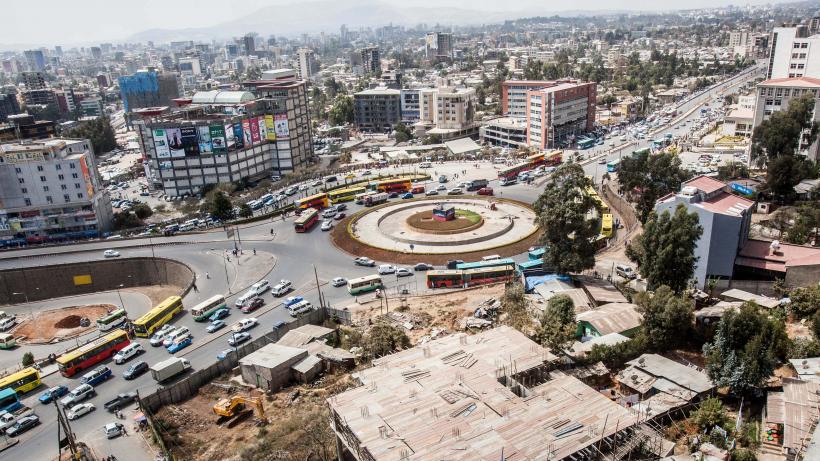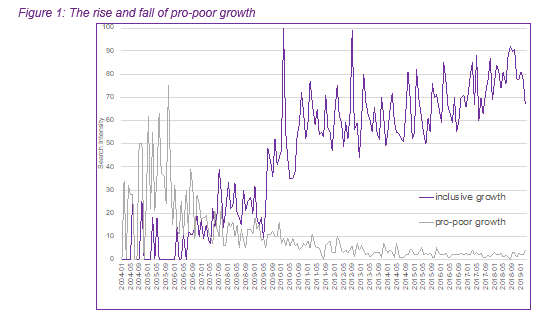
Inclusive growth for cities: Fuzzy, functional or forsaken?
The challenge: Inequality in cities
Inequality is one of the pressing issues of our time. China’s growth has reduced inequality globally, yet within countries, disparities have tended to increase. This increase in inequality has been most present in cities. Urban areas can be the most unequal: the benefits of scale and specialisation often failing to find their way to the poorest citizens’ pockets. Global narratives are useful in spurring action to reduce these inequalities. However, they must be used with caution. The catch-all nature of inclusive growth means targeting and measurement – the heart of evidence-based policy – can easily be lost in the fuzz.
Inequality becomes apparent in cities like Mumbai, India, where gleaming blue glass towers of business districts stand opposite blue corrugated iron roofs of informal communities and also in cities, like Dar es Salaam, Tanzania, where land for private pools lies opposite land without adequate sanitation. Both cases represent a breakdown in public policy. Yet both cases are not inevitable. Urban inequality is not a necessary result of growth and development. Rather, it can occur at any income level and is often a result of national development policy choices.
Fortunately, cities are able to fight back. There has been a ‘global trend to devolution’ which is most recently exemplified by Kenya’s legislative reforms. This trend has equipped some city decision makers with the tools to fight inequality. However, balancing the desire for growth with ensuring all citizens feel the gains is tricky. The role for policy is clear, but the approach to delivery is fraught with challenges.
The solution: pro-poor or inclusive growth?
International financial institutions (IFIs) and intergovernmental organisations (IGOs) have the task of somehow operationalising these ideas. The 2000s saw a concern that Washington Consensus policies had little impact on poverty. The response was a search for concepts, allying the need for growth with poverty reduction, which led to the concept of ‘pro-poor growth’. Growth still mattered, but so did the need to ease daily challenges of the vulnerable echelons of society, particularly those who felt no trickle-down benefits. This concept encouraged policymakers to refocus to achieving growth that would see lower income quintiles gain the most, but not at the expense of the broad middle, who would still benefit.
Pro-poor growth seemed to span the political and economic divide. In 2004 it had its heyday with ‘almost everybody in the development community talking about ‘pro-poor growth’. Yet following this peak came its downfall as a new growth policy was born – that of inclusive growth. (See Figure 1)

The issue of focusing on one group
Urbanization can be a key pro-poor policy for emerging countries. Cities and their prospects for prosperity offer a future from rural poverty. However, the problem with pro-poor growth is its focus on benefits to one particular group, the poor. Poverty is political and for international organisations which span multiple nations and governments, they must also span multiple opinions. National interest and thus redistributive policy can vary dramatically in each country. Interest in pro-poor growth has faded, and a new concept – inclusive growth – has taken its place.
As with pro-poor growth, inclusive growth concerns itself with the pace and pattern of development. However, inclusive growth is not necessarily pro-poor, it is pro-all. Pro-all further removed a need for politically difficult redistribution. This new agenda resonated well throughout the international communities: from the US, to Zambia and Nigeria as well as India and Philippines.
Despite global resonation, inclusive growth failed to find a common global understanding. Emblematic of this, the most googled phrases surrounding inclusive growth are about its meaning and definition. Internationally there is no universal agreement. Therefore, whilst policymakers and others liked what it stood for, they struggled to understand what it meant. This, in turn, was a challenge in providing clear policy direction.
Fuzzy: How is it conceptualized?
It may be that the precise reason why inclusive growth is so attractive is the precise reason its use should be with caution: it suffers from a fuzziness in its conceptualisation. UNDP’s Paloma Duran infamously quipped ‘when you ask five economists to define the concept, you will likely end up with six answers’. Our experience has been the opposite, we asked five economists to define the concept and the result was silence. This too does not provide much guidance for implementation.
As the policy community continues to strive towards evidence-based research, inclusive growth provides a barrier. Evaluation of change is impossible if policymakers cannot clearly articulate the desired path for change. With a concept like inclusive growth, who are meant to be the beneficiaries and what success looks like are very hard to quantify. The result can be researchers, policymakers, and practitioners believing they are addressing the same phenomena but instead actually targeting quite different ones.
There is a lack of evidence on the achievements and measurement of inclusive growth. One attempt found only four of 100 metro areas in the US, achieved growth, prosperity, and inclusion that benefited a majority of workers of all races and ethnicities. Yet, in loosening the definition of what ‘inclusivity’ involves, the successful implementation increased fourfold. The precise benefit of its fuzziness is its precise downfall for evidence-based policymaking.
Functional: Is it useful in policymaking?
Despite its fuzziness, the inclusive growth agenda has positive policymaking at its heart. It has also delivered change, with city policymakers, under the banner of inclusive growth, beginning to shape new policies and reshape old ones with distributional concerns at heart. For example, connectivity between poorer neighborhoods and richer suburbs is now a crucial part of the agenda in Cape Town, South Africa, and Medellin, Columbia.
Unfortunately, good intentions do not always correspond to good policy. DFID’s Economic Development Strategy highlights a need to avoid an overloaded reform agenda. If inclusive growth is to be functional then policymakers must understand whether their decisions to spend funds, time, and effort match desired outcomes. Therefore, developing a theory of change that clearly defines inputs, activities, outputs, outcomes, and impact will help build the evidence base for future decisions. Cape Town’s upcoming Inclusive Economic Growth Strategy will have to deliver on this. They can take lessons and input from India Poorest States Inclusive Growth Programme theory of change. Only with this framework in place can policymakers and researchers start evaluating whether and how real change is happening, and if this drive for inclusivity has indeed resulted in equitable gains from growth.
Forsaken: Is inclusive growth ultimately doomed?
The very nature of a concept like inclusive growth that is both difficult to operationalize and even harder to evaluate, may be to the detriment of its longer-term survival. Policymakers, taxpayers, and others will start questioning government spending and decisions that are done within such a nebulous area.
Yet, this is not a foregone conclusion. The mechanism or term of the day is secondary if it delivers positive socio-economic outcomes. Therefore, when faced with new fuzzy terms, like inclusive growth, policymakers can make great strides by narrowing down on three key questions:
1. The challenge – what are we trying to change?
2. The beneficiary – who are we trying to change this for?
3. The mechanism and evaluation – how can we tell if we have delivered?
By having these questions at the heart of policymaking, actions can be properly targeted and results measured, rather than being fuzzy or forsaken. It can be an important tool in taking us one step closer to creating cities that work.
This blog has also been posted on the World Bank blog Let’s Talk Development.
Editor’s Note: This blog is part of the IGC’s 10 year celebration series. This blog is linked to our work on cities driving growth.

